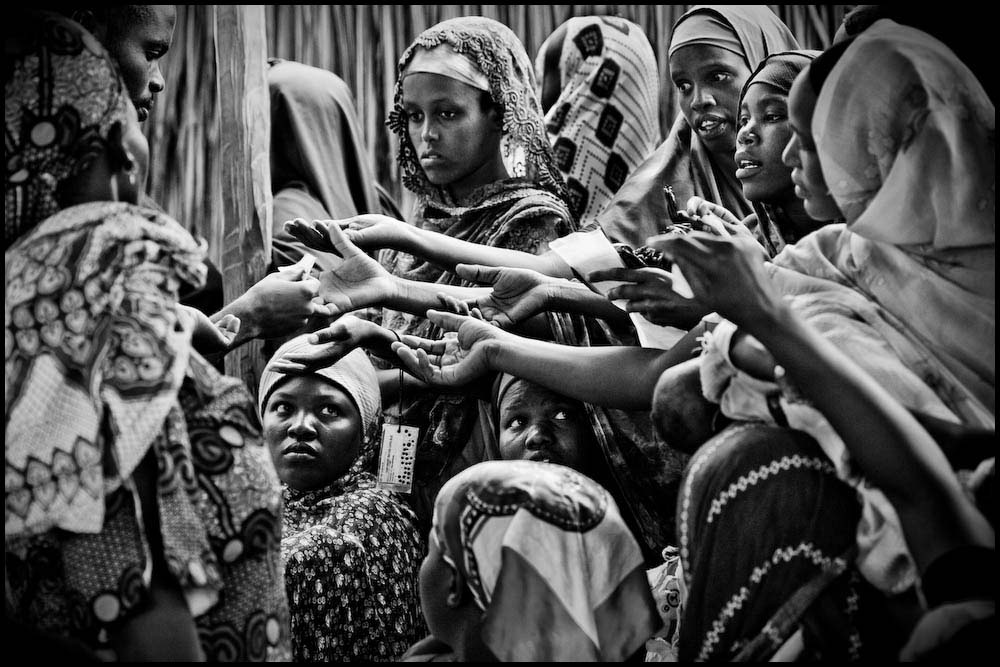Earlier this week, Mark wrote about a possible famine famine in the Horn of Africa. International organizations such as the Food and Agriculture Organization and the World Food Program, as well as a multitude of NGOs – Oxfam, Mercy Corps, Save the Children, etc. – are calling on donors to support their efforts at relieving hunger and averting a humanitarian disaster in the region.
Peter Gill, who recently wrote a book about famine in Ethiopia, has this to say about the impending famine in the Horn of Africa:
I have The Times of July 5 in front of me. ‘Spectre of famine returns to Africa after the worst drought for decades,’ says the main headline in World news. On page 11 there is a half-page appeal from Save the Children illustrated with a picture of a six-week old Kenyan called Ibrahim ‘facing starvation.’ On page 17 Oxfam has its own half page saying that ‘more than 12 million people have been hit by the worst drought in 60 years.’ The Times that day also carried a Peter Brookes cartoon of a hollow-faced African framed in the map of Africa, with his mouth opened wide for food.
So, for 2011, an image of Africa has again been fixed in the western consciousness. It is an image of suffering – worse, of an impotent dependence on outsiders – that most certainly exists, but is only part of the story, even in the Horn. (emphasis added)
The western world may understand something of the four-way colonial carve-up and the post-colonial disaster that overtook the Somali homeland, but it certainly has no proper answers to the conflicts and dislocation that lead to starvation and death. In northern Kenya, to which so many thousands of Somali pastoralists have fled in recent months, the West does have an answer of sorts – it can feed people in the world’s largest refugee camp, in the thin expectation of better times back across the border. Then there is Ethiopia, with several million of its own people needing help, its own Somali population swollen by refugees, and the country for ever associated with the terrible famine of 25 years ago which launched the modern era of aid.
In spite of our collective past experience of seeing food crises and famines unfold, overall the international community is still too focused on last-minute emergency interventions, an approach reinforced by a powerful and popular narrative that underscores African weakness and victimization. Gill continues:
The questions raised by the latest African food crisis are not for Africa alone. Ethiopia must keep addressing the image of destitution and the reality that too often underpins it, but it needs to promote other images as well. Instead of the risk of starvation, it also needs to be able to draw attention to impressive annual economic growth figures. Instead of food hand-outs, it also needs to be able to emphasise its big drive for inward investment.
The media can be held to account for the image it projects of Africa, and so must the aid organisations. Unlike the press, they set themselves ‘development’ objectives. When Meles Zenawi accepted some of the blame for underplaying the last Ethiopian food crisis, he also had harsh words for the aid-givers. He accused UN agencies and the NGOs of magnifying the country’s problems, and added: ‘My own interpretation of the reasons for exaggerating is because they have to shock and awe the international community in order to get money.’ Another campaign of ‘shock and awe’ has just got under way.
In highlighting Gill’s argument, I’m not suggesting that the international community should eschew necessary emergency aid and interventions to help protect vulnerable populations. Instead, I think there is an important truth in the notion that images of Africa as a continent full of powerless victims are part of a vicious cycle of irresponsibility.
Aid and international organizations, western donors (governments and individuals) and African governments are caught in a western-centric approach to humanitarian relief, where the effective mobilization of funds and good will seems to be proportionate to the inevitability of a crisis. In other words, there is still a lot to be done to appropriately deal with threats and improve local capacity to prevent famines – whether it be through the development of strong early prevention systems, improved strategic food reserves or improving access to agricultural and pastoral technology. The Guardian’s concluding paragraph in an editorial on this issue captures the sentiment: “As it is, aid agencies race from one drought to another. And the fact that the shortfall in WFP funding is 42% in Somalia, and 67% in Ethiopia and Kenya, speaks volumes about the mentality of donors who are only moved to act when it is too late.”
In addition to improving our ability to deal with these threats early, there is also a real issue about supporting local capacity to respond to crises. In a post reflecting on fragile states, Oxfam’s Duncan Green quotes an internal Oxfam paper: “There is growing awareness that global humanitarian response needs to be turned on its head, shifting capacity and power to the South, particularly to national and local government institutions and civil society organisations, to prepare for, respond to, and lead humanitarian action. The world is moving away from a western-inspired, UN-centric model of humanitarian action to one which is much more diverse and localised, and sustainable. This is both a trend and a desirable outcome.” In some contexts, like the Dabaab refugee camp in Kenya and its half a million refugees, famines and other crises have to be addressed by a variety of actors – state, international, non-governmental. But, generally speaking, I think the idea of localizing humanitarian interventions is an important one. It would help to break the image of the “African victim”, which is still so powerful in the western mind.
Photo credit: Zoriah on Flickr
